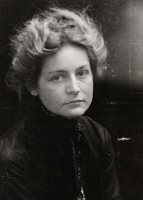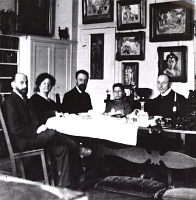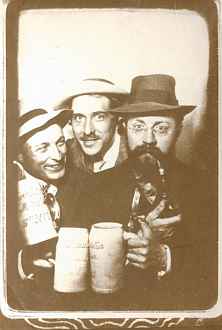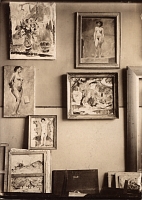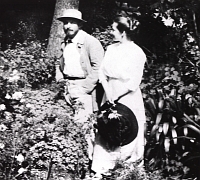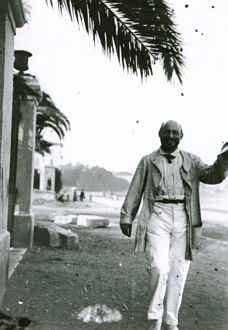Paris 1905-1914
1905
One of the main attractions of 1905 is the Manet exhibition at the Paris Autumn Salon. Purrmann goes to the Autumn Salon and views works by the “Fauves,” in particular Matisse and Derain. In November, he moves to Paris, spending his time, in the period before he had learned French, in the circle of German-speaking painters at the Café du Dôme. He is welcomed by Rudolf Levy, Walter Bondy, and Albert Weisgerber. Not only artists, but also collectors frequent the café, including Karl Ernst Osthaus, the critic Julius Meier-Graefe, and the future art dealer Alfred Flechtheim.
1906
Purrmann studies the works of Matisse in a series of additional exhibitions in the spring of 1906. Late that year, he comes into contact with Sarah and Leopold Stein, Matisse’s early patrons. Soon, he is attending their social jour fixe on Saturday evenings, where Pablo Picasso is also to be found. Purrmann begins to acquire paintings by Matisse and other French painters. His studio is at 17, rue Campagne Première, directly underneath the studio of his future wife Mathilde Vollmoeller (1876–1943), who had temporarily given the space to Rainer Maria Rilke.
1907
The major retrospective exhibition of Cézanne at the Autumn Salon is to be a defining experience for Purrmann, as well as for many other artists. In June, Purrmann, joined by Othon Friesz, visits
L’Estaque in search of Cézanne’s motifs. In a cave, they discover painted traces by the revered master. Among the German artists in Paris for the exhibition are Oskar and Margarete Moll, who were later to be among Purrmann’s collectors.
1908
In June, Purrmann takes his first journey with Matisse, traveling via Speyer, Munich, and Nuremberg to Heidelberg. At the urging of Sarah Stein and Hans Purrmann, the Académie Matisse is opened at the Couvent des Oiseaux in Paris, later moving to the Paris suburb of Issy-les-Molineaux. As “massier” (head) of the Académie, Purrmann is in charge of the studio and responsible for supervising the models. Among the students are Oskar Moll, Rudolf Levy, Friedrich Ahlers-Hestermann, Franz Nölken, and Mathilde Vollmoeller, a talented young painter, who exhibited at the Autumn Salon. She is the sister of the writer Karl Vollmoeller. Reminiscing about his teaching in 1951, Matisse said: “I made sure to go by from time to time in the evening to see what they were up to. Yet, it swiftly became clear that I had to devote myself to my own work, and that I was using up too much of my energy. After every critique, I saw myself surrounded by lambs, and over and over again I had to put them back on their feet to make lions out of them. And so I asked myself whether I was really a painter or a teacher. I concluded that I am a painter, and quickly gave up the school. Purrmann (member of, and professor at the Academy in Berlin), Grünwald (professor in Stockholm), and the Scandinavian Sörenson were my students.” (Matisse 1951, pp. 234–35).
Purrmann is given the task of preparing a Matisse exhibition for Cassirer’s gallery. This prompts the second journey with Matisse from December of 1908 through January of 1909, taking the two men to Munich, Weimar, Hagen, and Berlin. In Berlin, they encounter difficulties and leave, disappointed (see Weidemann 2006, p. 7).
Purrmann is given the task of preparing a Matisse exhibition for Cassirer’s gallery. This prompts the second journey with Matisse from December of 1908 through January of 1909, taking the two men to Munich, Weimar, Hagen, and Berlin. In Berlin, they encounter difficulties and leave, disappointed (see Weidemann 2006, p. 7).
1909
The Berlin Gallery Cassirer shows works of Matisse (Kropmanns 2000, p. 102ff.)
Purrmann spends the summer in Cassis, on the Mediterranean in the south of France. Inspired by Matisse, Purrmann attempts a small number of sculptural works. He makes four standing nudes in plaster; these are not cast in bronze until after his death.
1910
In January, Purrmann views the Cézanne exhibition at Bernheim-Jeune in Paris. Together with Eugen von Kahler and Curt Glaser, he travels to England in June, where he goes to numerous galleries and makes drawings after paintings by William Turner and sculptures in the British Museum. It is believed that Purrmann also went to Holland on this tour, where he was able to study works by Rembrandt and Frans Hals (see Göpel 1961, p. 308). During the summer, he is in Collioure. October sees the third journey with Matisse; joined by Albert Marquet, they go to Munich to see the exhibition of Islamic art. In Munich, they meet with Hugo von Tschudi and engage in a heated discussion of Vincent van Gogh (Kropmanns 2000, p. 242ff.).
1911
Painting sojourns in Collioure and Ajaccio on Corsica. Purrmann and Mathilde meet in Munich in mid-October to resolve to marry the following year. Mathilde cares for her father Robert Vollmoeller in Stuttgart until his death at the end of October.
In Berlin, Purrmann displays works of his from Paris in a group show at Paul Cassirer.
In Berlin, Purrmann displays works of his from Paris in a group show at Paul Cassirer.
1912
Hans Purrmann and Mathilde Vollmoeller wed in Stuttgart on January 13. Mathilde describes the honeymoon journey to Ajaccio on Corsica in a letter of February 4, 1912 to Rilke: “Tall rubber trees, mimosas in bloom, geraniums and roses, and an abandoned, forsaken city, nearly without guests, the gardens grown wild around the closed-off houses. We want to find a place to stay for months, and to ask humbly to come in and acquaint ourselves better with these majestic trees, cliffs, sea, and walls. Until perhaps the heat drives us off, who knows, perhaps you know Corsica? For us it is a step up from the south of France, and from every angle invites us to work.” (Rilke-Vollmoeller 2001, p. 94) But Mathilde falls sick with malaria and returns to Germany early, alone, to recover.
A daughter, Christine (1912–1993), is born on November 23; she will become a famous pianist in the nineteen-fifties. Owing to the birth of his daughter, Purrmann stays with his wife and child in Beilstein, near Heilbronn, where he creates a number of paintings. Beilstein is the domicile of the Vollmoellers, acquired by Robert Vollmoeller, and occupied and overseen by Elisabeth Wittenstein, Mathilde’s sister. Purrmann frequently visits this town.
A daughter, Christine (1912–1993), is born on November 23; she will become a famous pianist in the nineteen-fifties. Owing to the birth of his daughter, Purrmann stays with his wife and child in Beilstein, near Heilbronn, where he creates a number of paintings. Beilstein is the domicile of the Vollmoellers, acquired by Robert Vollmoeller, and occupied and overseen by Elisabeth Wittenstein, Mathilde’s sister. Purrmann frequently visits this town.
1913
Purrmann finds a new apartment in Paris and sends Mathilde letters with floor plans for lodgings on the rue d’Arras. He acquires a painting by Auguste Renoir out of admiration for the latter man. He also makes the acquaintance of the collector Richard Götz, who focused on Georges Seurat.
1914
A son, Robert (1914–1992), is born in Paris on January 30.






